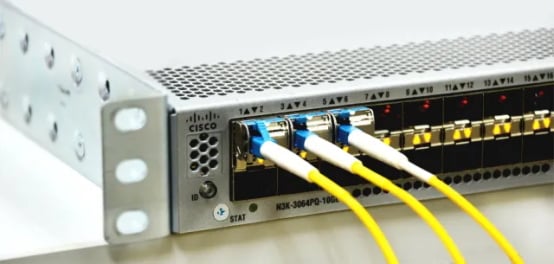Have you ever been puzzled about whether to choose Bidirectional SFP (BiDi SFP) modules or traditional SFP modules for your network cabling? What are the differences between them? Which one is more suitable for your network environment? Fiber-Mart will provide you with a detailed analysis of these two types of modules and help you make the best choice.

Basic Principle: One Fiber vs. Two Fibers
Traditional SFP modules are a very common type of optical transceiver in network equipment, usually requiring two separate optical fibers for communication: one for transmitting data (TX) and the other for receiving data (RX). This design is relatively simple but requires more optical fiber resources.
Bidirectional SFP modules, on the other hand, use Wavelength Division Multiplexing (WDM) technology to transmit and receive data simultaneously over a single fiber. This significantly simplifies the fiber cabling requirements by requiring only one fiber for bi-directional communication.

Wavelength and Transmission Direction: Who Sends, Who Receives?
In traditional SFP modules, each module uses two different wavelengths to handle transmission and reception separately. For example, one wavelength (such as 1310nm) is used for transmitting data, and another wavelength (such as 1550nm) is used for receiving data. This increases the complexity of cabling due to the need for two fibers.
Bidirectional SFP modules use two different wavelengths over a single fiber for bi-directional communication. For example, one wavelength is used for sending data, and another wavelength is used for receiving data. This not only improves fiber utilization but also reduces cabling complexity, making network deployment more flexible.

Applicable Scenarios: Which One is Right for You?
Traditional SFP modules are widely used in data centers, enterprise networks, and other scenarios requiring separate transmission and reception paths. These scenarios usually have ample fiber resources to support the cabling requirements of two fibers.
Bidirectional SFP modules are particularly suitable for scenarios with limited fiber resources, such as Fiber to the Home (FTTx) deployments, point-to-point (P2P) connections, etc. In these scenarios, Bidirectional SFP modules reduce cabling costs by decreasing the number of fibers needed, while improving network deployment efficiency.

Cost Efficiency: The Money You Spend and the Peace of Mind You Get
Traditional SFP modules are relatively simple in design, so the cost per module is relatively low. However, due to the need for two fibers for communication, the overall cabling cost is higher, especially when fiber resources are limited.
Although Bidirectional SFP modules may have a higher cost per module, their ability to perform bi-directional communication over a single fiber can significantly reduce the overall cabling cost. In environments requiring long-distance transmission or with limited fiber resources, Bidirectional SFP modules offer significant economic benefits.
Compatibility and Configuration: Matching Matters
Traditional SFP modules are widely used and generally compatible with various network devices and protocols, including Gigabit Ethernet, Fiber Channel, and SONET/SDH. These modules comply with the Multi-Source Agreement (MSA), ensuring broad compatibility.
Bidirectional SFP modules also have good compatibility but require careful pairing during configuration. For example, if one end uses a BiDi SFP module with TX 1310nm/RX 1550nm, the other end must use a corresponding module with TX 1550nm/RX 1310nm to ensure normal communication.

Transmission Distance and Performance: Who Can Go Further?
The transmission distance of traditional SFP modules depends on the specific type and wavelength used. Multi-mode SFP modules are suitable for short-distance transmission (usually no more than 500 meters), while single-mode SFP modules support longer distances (up to 100 kilometers or more).
Bidirectional SFP modules also support various transmission distance requirements, from short distances to long distances. For instance, some BiDi SFP modules can support transmission distances up to 120 kilometers, making them ideal for various network deployment needs.
Maintenance and Management: Which is Easier?
Traditional SFP modules require two fibers for communication, making cabling and maintenance more complex. Especially in fiber patch cord management, it is crucial to ensure correct connection and management of each pair of fibers.
Bidirectional SFP modules, requiring only a single fiber, make cabling and maintenance relatively simpler. This design reduces the number of ports on the fiber patch panel, optimizes fiber management, and decreases the space needed for cabling, making daily maintenance more convenient.
Conclusion: Which Module is Right for You?

Should you choose Bidirectional SFP or traditional SFP modules? The answer is simple: it depends on your specific needs. If your network environment has ample fiber resources and requires stable and reliable transmission, traditional SFP modules are undoubtedly a good choice. However, if you want to optimize cabling costs and improve deployment efficiency in an environment with limited fiber resources, Bidirectional SFP modules are definitely your best choice!
To help you make an easy decision, we highly recommend Fiber-Mart’s BiDi SFP transceivers. These Bidirectional SFP modules not only support Fast Ethernet, Gigabit Ethernet, Fiber Channel, and SONET/SDH applications but also offer transmission distances up to 120 kilometers. Whether you are an enterprise user or a data center administrator, Fiber-Mart’s BiDi SFP modules can provide you with an efficient and stable network experience.
Shop now and make your network more efficient and cost-effective!














No comments have been posted yet.